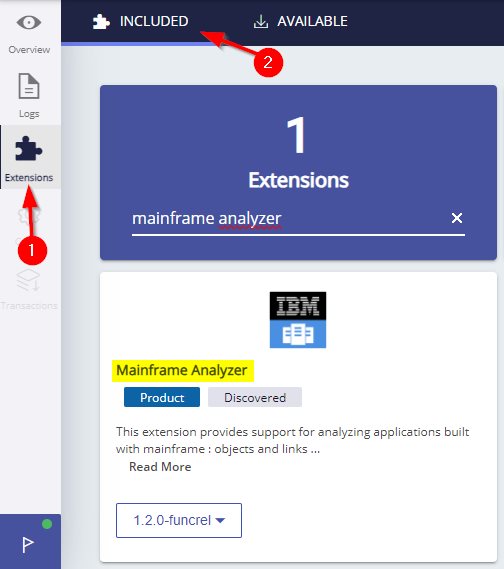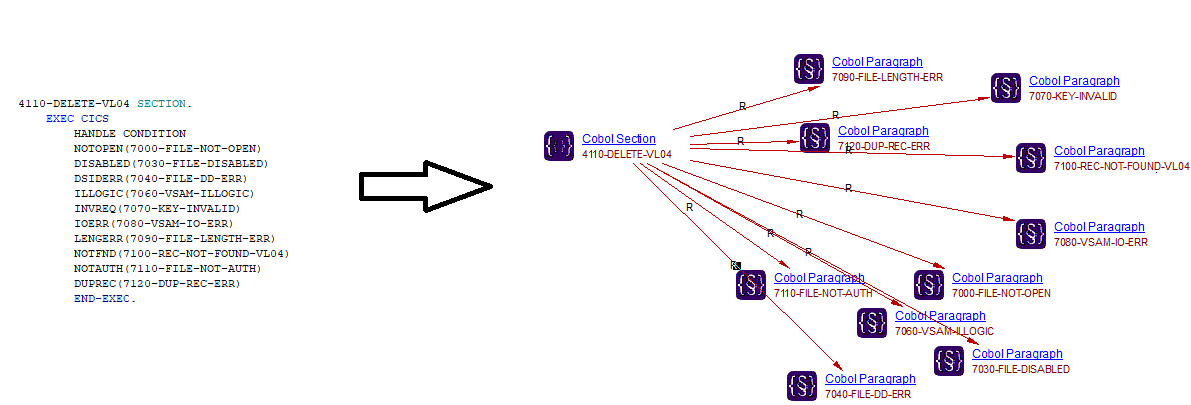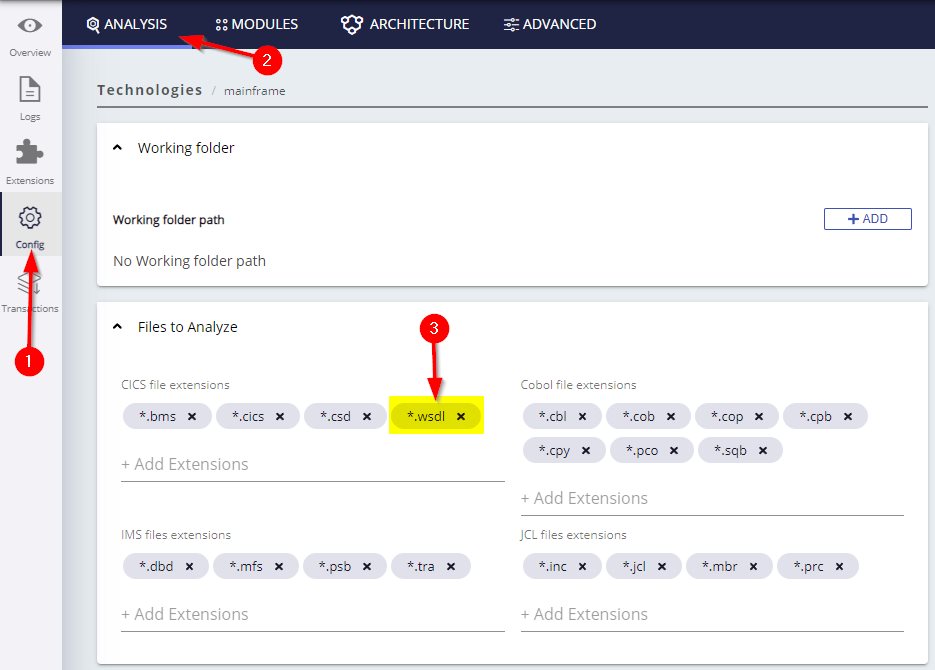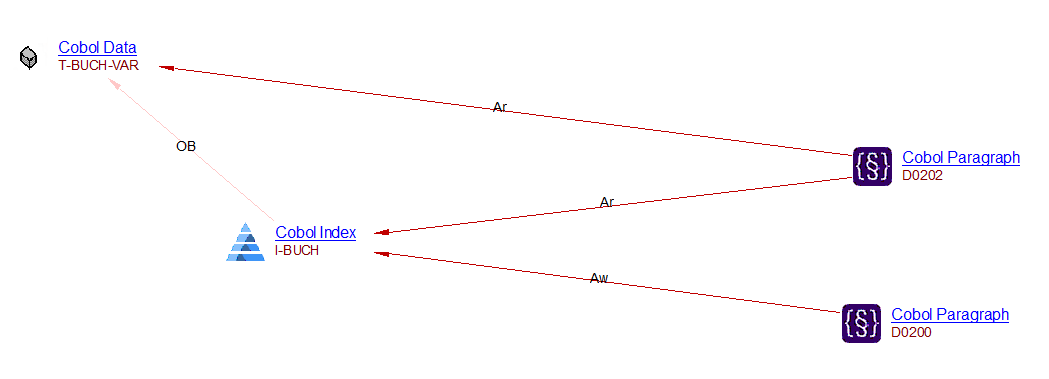Mainframe Analyzer - 2.0
Extension ID
com.castsoftware.mainframe
What’s new?
See Release Notes.
Description
This extension provides support for Mainframe (Cobol, CICS, JCL, IMS…). If your application contains Mainframe source code and you want to view these object types and their links with other objects, then you should install this extension.
Isofunctionality
This release of the extension is based on the previous 1.4.x releases. Please check the release notes for more information.
Function Point, Quality and Sizing support
- Function Points (transactions): a green tick indicates that OMG Function Point counting and Transaction Risk Index are supported
- Quality and Sizing: a green tick indicates that CAST can measure size and that a minimum set of Quality Rules exist
| Function Points (transactions) | Quality and Sizing |
|---|---|
| ✅ | ✅ |
Compatibility
| Release | Operating System | Supported |
|---|---|---|
| v3/8.4.x | Microsoft Windows / Linux | ✅ |
| v2/8.3.x | Microsoft Windows | ❌ |
Dependencies with other extensions
Some extensions require the presence of other extensions in order to function correctly. The Mainframe Analyzer extension requires that the following other extensions are also installed:
Note that when using CAST Imaging Console to install the extension, any dependent extensions are automatically downloaded and installed for you. You do not need to do anything.
Download and installation instructions
For Mainframe applications, the extension will be automatically installed by CAST Imaging Console:

What results can you expect?
Objects
Cobol
| Icon | Description |
|---|---|
 |
Cobol Class |
 |
Cobol Conditional Test |
 |
Cobol Constant Data |
 |
Cobol CopyBook |
 |
Cobol Data |
 |
Cobol Data Link |
 |
Cobol Declarative Block |
 |
Cobol Declarative Paragraph |
 |
Cobol Declarative Section, Cobol Section |
 |
Cobol Directory/Root Directory |
 |
Cobol Division |
 |
Cobol Entry Point |
 |
Cobol File Link (Sequential, Partitioned, VSAM) |
 |
Cobol Index |
 |
Cobol Interface |
 |
Cobol Literal |
 |
Cobol Paragraph |
 |
Cobol Nested Program |
 |
Cobol Program |
 |
Cobol Structure Data |
 |
Cobol Transaction |
 |
Cobol SQL Query |
 |
Publisher IBM MQ |
 |
Subscriber IBM MQ |
JCL
| Icon | Description |
|---|---|
 |
JCL Data Set (Sequential, Partitioned, VSAM) |
 |
JCL Directory/Root Directory |
 |
JCL External Procedure |
 |
JCL External Program |
 |
JCL Included File / Included Not Found |
 |
JCL Index |
 |
JCL In-stream Procedure |
 |
JCL to Java Program |
 |
JCL (Catalogued) Job |
 |
Unknown JCL Procedure |
 |
JCL (Catalogued) Job Prototype |
 |
JCL (Catalogued) Procedure |
 |
JCL Project |
 |
JCL Step |
 |
JCL SQL Query |
IMS
| Icon | Description |
|---|---|
 |
IMS Alternate Program Control Block |
 |
IMS Database Program Control Block |
 |
IMS DB Definition |
 |
IMS DB Field |
 |
IMS Directory/Root Directory |
 |
IMS File / Transaction File |
 |
IMS GSAM Program Control Block |
 |
IMS Message Format Service |
 |
IMS Message Input Descriptor |
 |
IMS Message Output Descriptor |
 |
IMS Program Control Block |
 |
IMS Program Specification Block |
 |
IMS Project |
 |
IMS Segment / DB Segment |
 |
IMS Transaction |
 |
IMS SQL Query |
CICS
| Icon | Description |
|---|---|
 |
CICS DataSet |
 |
CICS DB2 Transaction |
 |
CICS Definition File |
 |
CICS External File |
 |
CICS Folder |
 |
CICS Group |
 |
CICS Map |
 |
CICS MapSet |
 |
CICS Map Definition |
 |
CICS Project |
 |
CICS Temporary Storage |
 |
CICS Transaction |
 |
CICS Transient Data |
 |
CICS SOAP Operation |
 |
CICS SOAP Operation Call |
Links
Cobol
| Link Type | Calling Linked Objects | Called Linked Objects | Code Example |
|---|---|---|---|
CALL PROG*
|
Program, section or copybook | Program or entrypoint | CALL "CC2DISPLAY" |
| CALL TRANSAC* | Program, section or copybook | Program or entrypoint | EXEC CICS XCTL PROGRAM(TEST) END EXEC |
| CALL PERFORM | Program, section or sub-object | Section or paragraph | MODULE-ENTREE
SECTION. * * LA LIGNE CI DESSOUS DOIT ETRE DELETEE APRES LES TESTS * MOVE '*** EXECUTION STARTEE NORMALEMENT ***' TO MESS. DISPLAY MESS. MOVE SPACE TO MESS. * PERFORM LECTURE-PARAM. * FIN-MODULE-ENTREE. EXIT. EJECT * COPY SYBPINIT. |
| CALL GOTO | Program | First executed section or paragraph | **************** LECTURE-PARAM SECTION. **************** * READ MEF001. IF FILE-STATUS NOT = '00' DISPLAY 'CODE RETOUR' FILE-STATUS DISPLAY 'CARTE PARAMETRE INEXISTANTE : ' CODE-ABEND GO TO SORTIE-ERREUR END-IF. * |
| CALL GOTO | Section | First executed paragraph in section | Same example as above. |
| CALL GOTO | Paragraph | Next executed paragraph in same section | Same example as above. |
| CALL | Section/Paragraph | Section/Paragraph | When Sections or Paragraphs are sequentially executed (one after the other) a Call link will be generated. For example, if a program is made of Section A then Section B then Paragraph C then Section D, the links will be resolved as A -> B -> C -> D. |
| INCLUDE | Program or Copybook | Copybook | * -ACDA * MNPW * * * *
* * * * * * * * * * * * * * * * * * * * * * FD DU FICHIER INF103 PAR LE CHEMIN INF103 * * * * * * * * * * * * * * * * * * * * * * * * * * * * * * * * * * BLOCK CONTAINS 0. * COPY INF103 REPLACING INF103 BY ING103. |
| USE | Calls to matched character strings |
Calls to matched character strings |
Display "a string" |
| USE | Cobol Program, Cobol Section, Cobol Paragraph | Program Specification Block | EXEC DLI SCH PSB (MYPSB) END-EXEC |
| ACCESS OPEN | Cobol Program or sub-object |
Cobol File Link or Cobol Data Link |
*========================================================
* OUVERTURE DU FICHIER IAHCDECE
*========================================================
OPEN-IAHCDECE. OPEN INPUT IAHCDECE. *======================================================== * LECTURES DU FICHIER IAHCDECE *======================================================== LECT-IAHCDECE. READ IAHCDECE. *======================================================== * FERMETURE DU FICHIER IAHCDECE *======================================================== CLOSE-IAHCDECE. CLOSE IAHCDECE. *======================================================== *
LECTURE-SEGMENT-CISRAPMP
*======================================================== *======================================================== |
| ACCESS CLOSE | Cobol Program or sub-object |
Cobol File Link or Cobol Data Link |
Same example as above. |
| ACCESS READ | Cobol Program or sub-object, Cobol Section, Cobol Paragraph |
Cobol File Link,
Cobol Data Link, Constant Data, Structured Data, Data, Conditional Test,
Program Communication Block |
Same example as above. |
| ACCESS WRITE | Cobol Program or sub-object, Cobol Section, Cobol Paragraph |
Cobol File Link,
Cobol Data Link, Constant Data, Structured Data, Data, Conditional Test,
Program Communication Block |
Same example as above. |
For Embedded SQL links, the following are valid for all servers:
| Link Type | Description | Code Example |
|---|---|---|
| USE SELECT | This type is reserved for server side object referencing | EXEC SQL… SELECT |
| USE UPDATE | As above. | EXEC SQL… UPDATE |
| USE INSERT | As above. | EXEC SQL… INSERT |
| USE DELETE | As above. | EXEC SQL… DELETE |
| CALL | As above. | EXEC SQL… CAL |
For link types CALL PROG and CALL TRANSAC, two limitations exist when the call is in “string” form:
- If the string is constant and declared in the “data-division” section, the entry point will be resolved in the normal way.
- If the string is dynamic, the program may be found by the Dynamic Link Manager.
In addition, the following **Embedded SQL links **are valid for DB2 only:
| Link Type | Description | Code Example |
|---|---|---|
| DEPEND ON | This type is reserved for server side object referencing on structured or distinct UDTs. | - |
| DDL CREATE | This type is reserved for server side object referencing on Tables | - |
| DDL DROP |
JCL
| Link Type | Calling Linked Objects | Called Linked Objects |
|---|---|---|
| ACCESS WRITE | JCL Step | JCL Data Set |
| ACCESS READ | JCL Step | JCL Data Set |
| ACCESS EXECUTE | JCL Step | JCL Data Set |
| PROTOTYPE | Cobol File Link | JCL Data Set |
| PROTOTYPE | Cobol Data Link | JCL Data Set |
| PROTOTYPE | JCL Data Set | Cobol JCL Program |
| CALL | JCL Step | Cobol JCL Program |
| CALL | JCL Job | JCL Step |
| CALL | JCL Procedure | JCL Step |
| CALL | JCL Step | JCL Procedure |
| USE | JCL Step | IMS DBD |
| MONITOR AFTER | JCL Step | JCL Step |
IMS
| Link Type | Calling Linked Objects | Called Linked Objects |
|---|---|---|
| ACCESS WRITE | IMS PC Block | IMS Segment |
| USE | IMS PC Block | IMS DBD or IMS GSAM File |
CICS
| Link Type | Calling Linked Objects | Called Linked Objects |
|---|---|---|
| CALL TRANSAC | CICS Transid | Client/Cobol Program |
For Transactional Code, the following are valid:
| Link Type | Calling Linked Objects | Called Linked Objects | Code Example |
|---|---|---|---|
| CALL TRANSAC | Client/Cobol Program or its Sub object | Client/Cobol Program | EXEC CICS XCTL or EXEC CICS LINK |
| CALL TRANSAC | Client/Cobol Program or its Sub object | CICS Transaction | EXEC CICS START or EXEC CICS RETURN |
| MONITOR | Client/Cobol Program or its Sub object | CICS Map | EXEC CICS SEND MAP (W-CIC-CMAPCUR) MAPSET (W-CIC-CMPSCUR) FROM (MGAB10O) ERASE FREEKB FRSET CURSOR END-EXEC or EXEC CICS |
| ACCESS OPEN
ACCESS CLOSE ACCESS READ ACCESS WRITE |
Client/Cobol Program or its Sub object | CICS Dataset | ENDBR, DELETE, LINK, READ, READNEXT, READPREV, REWRITE, STARTBR, XCTL, WRITE ex: EXEC CICS |
| ACCESS READ
ACCESS WRITE |
Client/Cobol Program or its Sub object | CICS Transient Data | DELETEQ, READQ, WRITEQ
ex: EXEC CICS DELETEQ TD QUEUE (W-CIC-TSQ-LNOM) |
Structural rules
All Mainframe Analyzer related rules are provided in the default CAST Assessment Model shipped with CAST Imaging Core: https://technologies.castsoftware.com/AIP/technologies/-4/ .
Additional information
Rules for resolving Paragraph names in a Section
The Mainframe Analyzer (Cobol) uses the following rules when resolving Paragraph names defined in Sections:
- If the referenced Paragraph is located in the current Section, Cobol Analyzer will link the calling Paragraph to the called Paragraph
- If the referenced Paragraph is not located in the current section, Cobol Analyzer will issue a syntax error
- If the referenced Paragraph has a unique declaration outside the Section, Cobol Analyzer will create a link to this Paragraph.
- The following syntax is also resolved: “Paragraph Name IN/OF Section Name”. A link will be created to the correct Paragraph (which will be outside the current Section).
Access type links
Access type links are created when your Cobol program calls an external file (Data Set).
-
The instructions that manage classic files (‘File Link’ type) are:
Instructions for opening a file: OPEN Reading data: READ Writing data: WRITE, REWRITE Closing the file: CLOSE
-
Sorting operations on data set files (Data Link type) are carried out via the instructions MERGE and/or SORT. These instructions should generate CALL + PERFORM type links on paragraphs or sections. OPEN and CLOSE instructions are also used.
-
Access (Read/Write) links to “Cobol Constants” and “Cobol Data”:
- Variables used in the flow control: IF, PERFORM, EVALUATE, SEARCH.
- Inclusion of the instructions: MOVE, INITIALIZE, SET, CALL, OPEN, CLOSE, READ, WRITE, REWRITE, MERGE, SORT.
- The following instructions are not yet included: MULTIPLY, SUBTRACT, ADD, DIVIDE, EXHIBIT.
-
CICS files read via CICS instructions in an EXEC CICS … END-EXEC
- Opening of file - Instructions: STARTBR – Acesse(Open) on the file
- Data reading - Instructions: DELETE, WRITE, REWRITE – Access(Write)
- Closing of file - Instruction: ENDBR – Access(Close)
-
Access to the segment in the IMS databases:
- Links to the segment (Access + Write/Read)
- Links to the Program Specification Block
Logical Files are declared in the “File Section” part of the program with the FD or SD tag.
- FD: declaration of ‘file link’ type
- SD: declaration of ‘data link’ type
Example declaration of a logical file called MAIL-XREF (type FILE-LINK) in the Cobol program:
004600 FILE SECTION. 00015900
004700 00016000
009000 FD MAIL-XREF 00020700
009100 LABEL RECORDS ARE STANDARD 00020800
009200 BLOCK CONTAINS 0 RECORDS. 00020900
009300 01 MAIL-XREF-REC. 00021000
009400 03 MAIL-XREF-KEY. 00021100
009500 07 MAIL-XREF-ADDRESS. 00021200
009600 11 MAIL-XREF-ZIP-PRE PIC X(05). 00021300
009700 11 MAIL-XREF-ZIP-SUF PIC X(04). 00021400
009800 07 MAIL-XREF-STATE PIC X(03). 00021500
009900 07 MAIL-XREF-CITY PIC X(25). 00021600
010000 07 MAIL-XREF-POSTAL-CODE PIC X(02). 00021700
010100 03 MAIL-XREF-DATA PIC X(324). 00021800
Replacement used in COPY REPLACING directives
- Replacements can be applied to words or parts of words
- Patterns used to replace parts of words must be delimited by the following characters: :, (, ), \ or "
- Patterns that are not delimited by the above characters are considered as being used to replace entire words
- LEADING and TRAILING clauses mean that the replacement will be applied on parts of words and as such, patterns must respect rule two (first character and last character will be removed from the pattern).
Embedded SQL support
For each embedded SQL statement found in Cobol (except INCLUDE statements which are already supported via a CopyBook object), an object called Cobol SQL Query is created. For example, the following code will cause this object type to be created:
EXEC SQL
SELECT ABCDED
FROM TABLE
END-EXEC
ReferLink between paragraphs/sections
A ReferLink is added between sections/paragraphs containing the CICS command HANDLE ABEND LABEL and the sections/paragraphs specified in the LABEL clause. For example:

In the same way, a ReferLink is added for the CICS commands HANDLE AID and HANDLE CONDITION:

Below is a list of supported conditions:
| CICS command | Condition |
|---|---|
| HANDLE ABEND | LABEL |
| HANDLE AID | ANYKEY, CLEAR, CLRPARTN, ENTER, LIGHTPEN, OPERID PA1, PA2, PA3, PF1 - PF24, TRIGGER |
| HANDLE CONDITION | ALLOCERR, CBIDERR, CHANNELERR, DISABLED, DSIDERR, DSSTAT, DUPKEY, DUPREC, END, ENDDATA, ENDFILE, ENDINPT, ENQBUSY, ENVDEFERR, EOC,EODS, EOF, ERROR, EXPIRED, FUNCERR, IGREQCD, IGREQID, ILLOGIC, INBFMH, INVERRTERM, INVEXITREQ, INVLDC, INVMPSZ, INVPARTN, INVPARTNSET, INVREQ, IOERR, ISCINVREQ, ITEMERR, JIDERR, LENGERR, LOADING, LOCKED, MAPFAIL, NETNAMEIDERR, NODEIDERR, NOJBUFSP, NONVAL, NOPASSBKRD, NOPASSBKWR, NOSPACE, NOSPOOL, NOSTART, NOSTG, NOTALLOC, NOTAUTH, NOTFND, NOTOPEN, OPENERR, OVERFLOW, PARTNERIDERR, PARTNFAIL, PGMIDERR, QBUSY, QIDERR, QZERO, RDATT, RECORDBUSY, RESUNAVAIL, RETPAGE, ROLLEDBACK, RTEFAIL, RTESOME, SELNERR, SESSBUSY, SESSIONERR, SIGNAL, SPOLBUSY, SPOLERR, STRELERR, SUPPRESSED, SYSBUSY, SYSIDERR, TERMERR, TASKIDERR, TERMIDERR, TRANSIDERR, TSIOERR, UNEXPIN, USERIDERR, WRBRK |
Support for CICS Webservices
Web services make the interactions between programs over a network. There are two types of CICS Webservice:
- Provider: CICS acting as server to provide information
- Requester: CICS acting as client to request information
For example:

The items highlighted with a green oval represent the new objects and the new links to existing Mainframe type objects. Where:
- Cob program ECHOCLNT: client program to invoke the cob program which handles the CICS Webservice
- Cob program ECHOPROG: the cob program which handles the CICS Webservice as a Provider
- Cob program ECHOWEBS: the cob program which handles the CICS Webservice as a Requester
- CICS Webservice and Call to CICS Webservice: new objects which represents CICS webservice support
- JCL Step LS2WS: JCL step which run a Webservice utility batch to create a web service provider in CICS
- JCL Step WS2LS: JCL step which run a Webservice utility batch to create a web service requester in CICS
Example Provider Webservice
SAMPLE1.jcl job has the LS2WS step which run the DFHLS2WS webservice utility and exposed ECHOPROG cob program as a Webservice Provider:
//LS2WS EXEC DFHLS2WS,
// JAVADIR='java142s/J1.4',
// USSDIR='cics650',
// PATHPREF='',
// TMPDIR='/tmp',
// TMPFILE='ls2ws'
//INPUT.SYSUT1 DD *
LOGFILE=<Install_Directory>/ca1p/wsbind/provider/*
echoProgProviderBatch.log
PDSLIB=//<INSTALL_HLQ>.CA1P.COBCOPY
REQMEM=ECHOCOMM
RESPMEM=ECHOCOMM
LANG=COBOL
PGMNAME=ECHOPROG
URI=ca1p/echoProgProviderBatch
PGMINT=COMMAREA
WSBIND=<Install_Directory>/ca1p/wsbind/provider/*
echoProgProviderBatch.wsbind
WSDL=<Install_Directory>/ca1p/wsdl/echoProgProviderBatch.wsdl
MAPPING-LEVEL=1.2
The parameter PGMNAME specifies the name of the cob program that will be exposed as a web service. The parameter URI specifies the URI link for the web service. An object CICS Webservice with the name as URI is created and linking with the Cobol Program which is the handle of CICS Webservice as a Provider.
Example Requester Webservice
SAMPLE2.jcl job has the WS2LS step which run the DFHWS2LS webservice utility and exposed ECHOWEBS cob program as a Webservice Requester:
//WS2LS EXEC DFHWS2LS,
// JAVADIR='java142s/J1.4',
// USSDIR='cics650',
// PATHPREF='',
// TMPDIR='/tmp',
// TMPFILE='WS2LS'
//INPUT.SYSUT1 DD *
LOGFILE=<Install_Directory>/ca1p/wsbind/requester/*
echoProgRequesterBatch.log
PDSLIB=//<INSTALL_HLQ>.CA1P.COBCOPY
REQMEM=ECHOPI
RESPMEM=ECHOPO
LANG=COBOL
WSBIND=<Install_Directory>/ca1p/wsbind/requester/*
echoProgRequesterBatch.wsbind
WSDL=<Install_Directory>/ca1p/wsdl/echoProgRequesterBatch.wsdl
MAPPING-LEVEL=1.2
ECHOWEBS.cob must consist of a CICS invoke webservice command linking to the same webservice resource echoProgRequesterBatch in the above code:
MOVE 'echoProgRequesterBatch'
TO WS-WEBSERVICE-NAME
EXEC CICS INVOKE WEBSERVICE(WS-WEBSERVICE-NAME)
CHANNEL(WS-CHANNEL-NAME)
OPERATION(WS-OPERATION-NAME)
RESP(COMMAND-RESP) RESP2(COMMAND-RESP2)
END-EXEC
echoProgRequesterBatch.wsdl is the webservice resource file which must consist the URI for webservice:
<service name="ECHOPROGService">
<port binding="tns:ECHOPROGHTTPSoapBinding" name="ECHOPROGPort">
<!--This soap:address indicates the location of the Web service over HTTP.
Please replace "my-server" with the TCPIP host name of your CICS region.
Please replace "my-port" with the port number of your CICS TCPIPSERVICE.-->
<soap:address location="http://my-server:my-port/ca1p/echoProgProviderBatch"/>
<!--This soap:address indicates the location of the Web service over HTTPS.-->
<!--<soap:address location="https://my-server:my-port/ca1p/echoProgProviderBatch"/>-->
<!--This soap:address indicates the location of the Web service over WebSphere MQSeries.
Please replace "my-queue" with the appropriate queue name.-->
<!--<soap:address location="jms:/queue?destination=my-queue&connectionFactory=()&targetService=/ca1p/echoProgProviderBatch&initialContextFactory=com.ibm.mq.jms.Nojndi" />-->
</port>
</service>
An object Call To CICS Webservice with the name as URI is created and linking with cobol program/section which invoke CICS Webservice.
Linking CICS Webservice objects and Call To CICS Webservice objects
The CICS Webservice object and Call To CICS Webservice object have the same URI for linking purposes.
Configuration
In order for CAST to be able to fully support CICS Webservices, the extension ***.wsdl **must be manually added to the CICS File Extensions option in the configuration of Mainframe extension in CAST Console:

Note: the file extension .wsdl will be added to the CICS File Extensions option by default in a future release of CAST Core.
Links to RPG objects
Cobol File Link objects will link to DDS Display File /DDS Printer File/ DDS Physical File / DDS Logical File of RPG which has the same object name:

Links to Cobol Program objects
Support EXEC CICS LOAD PROGRAM
A useLink link will added from Cobol Section objects to Cobol Program objects when the EXEC CICS LOAD PROGRAM statement is used:
EXEC CICS LOAD PROGRAM ('ME00000B')

Support EXEC CICS HANDLE ABEND PROGRAM
A referLink will be added from Cobol Section objects to Cobol Program objects when the EXEC CICS HAND ABEND PROGRAM statement is used:
EXEC CICS HANDLE ABEND PROGRAM ('ME00000A')

Support INDEX BY
A new object type Cobol Index is created with a RelyON Link to cobol data using INDEX BY statement, other links are created to the new Cobol Index Object when it is referenced:
15 T-BUCH-VAR OCCURS 1000 ASCENDING KEY
T-BUCH-ST-2-20
INDEXED BY I-BUCH.
...
D0200.
SET I-BUCH TO 1.
D0202.
MOVE T-BUCH-VAR (I-BUCH) TO V-BUCH.

Support PROCESSING PROCEDURE
Link between paragraphs is created when they are referenced in PROCESSING PROCEDURE statement:
1300-XML-PARSE.
XML PARSE WS-INT-XML-RESPONSE
( 1 : WS-INT-XML-RESPONSE-LEN )
PROCESSING PROCEDURE
1350-XMLEVENT-HANDLER THRU 1350-EXIT
END-XML

Embedded IMS SQL statements
For each embedded IMS SQL statement found in Cobol, an object called IMS SQL Query is created. For example, the following code will cause this object type to be created:
ENTERING-THE-PROGRAM.
EXEC SQLIMS SELECT CURRENT SERVER
INTO :CURRENT-SERVER
FROM SYSIBM.SYSDUMMY1
END-EXEC
